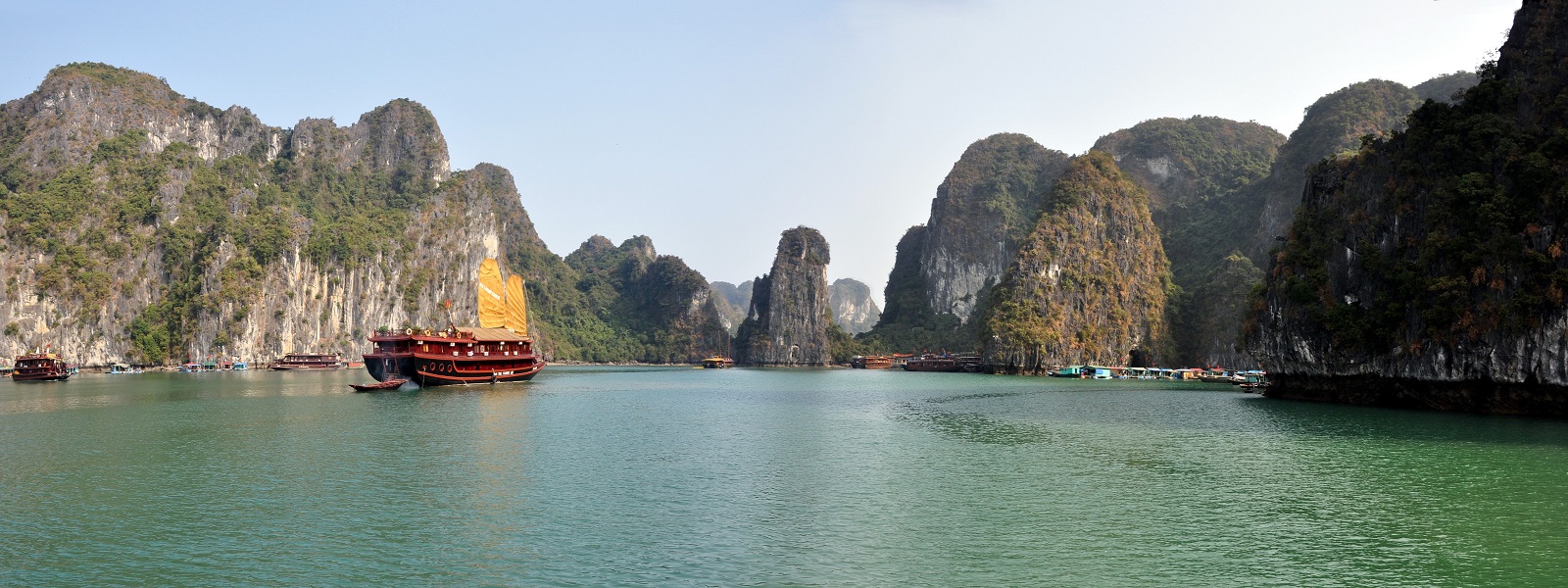
Situated in Gulf of Thailand, Phu Quoc rises from its slender southern tip like a genie released from a bottle. Fringed with white-sand beaches and with large tracts still cloaked in dense, tropical jungle, Phu Quoc rapidly morphed from a sleepy island backwater to a must-visit beach escape for Western expats and sun-seeking travelers.
Phu Quoc is as peaceful as it gets, and yet, this astonishing island is full of entertainment that will delight your adventurous side. Beach sports and water activities here are fantastic. Check out jet skiing, wind sailing, fishing, scuba diving and snorkeling. For more daring souls, don’t miss the chance to experience squid fishing. And when the night falls, the seafood night market is a must-go. Steamed wild fish and many local specialties found here definitely offer you a feast of heaven on earth.
Climate: Phu Quoc has tropical monsoonal sub equatorial climate which is characterized by the wet season (June to early November) and the dry season (December to April). May is the month where the transition from a dry to wet season begins.
Best time to visit:
High season - from November to March - can be considered as best time to visit Phu Quoc, since the weather is really mild and comfortable. The temperature in these months is usually around 25-280C and the humidity remains at the low level and the sky is clearly sunny, making it a great time to visit the island.
Situated in Gulf of Thailand, Phu Quoc rises from its slender southern tip like a genie released from a bottle. Fringed with white-sand beaches and with large tracts still cloaked in dense, tropical jungle, Phu Quoc rapidly morphed from a sleepy island backwater to a must-visit beach escape for Western expats and sun-seeking travelers.
Phu Quoc is as peaceful as it gets, and yet, this astonishing island is full of entertainment that will delight your adventurous side. Beach sports and water activities here are fantastic. Check out jet skiing, wind sailing, fishing, scuba diving and snorkeling. For more daring souls, don’t miss the chance to experience squid fishing. And when the night falls, the seafood night market is a must-go. Steamed wild fish and many local specialties found here definitely offer you a feast of heaven on earth.
Climate: Phu Quoc has tropical monsoonal sub equatorial climate which is characterized by the wet season (June to early November) and the dry season (December to April). May is the month where the transition from a dry to wet season begins.
Best time to visit:
High season - from November to March - can be considered as best time to visit Phu Quoc, since the weather is really mild and comfortable. The temperature in these months is usually around 25-280C and the humidity remains at the low level and the sky is clearly sunny, making it a great time to visit the island.
Getting here: A 20-minute-flight from Rach Gia (Mekong Delta) or 50-minute-flight from Ho Chi Minh City.: A 20-minute-flight from Rach Gia (Mekong Delta) or 50-minute-flight from Ho Chi Minh City.
Vietnam has a tropical monsoon climate, dominated by the south or southwesterly monsoon from May to September and the northeast monsoon from October to April. The southern summer monsoon brings rain to the two deltas and west-facing slopes, while the cold winter monsoon picks up moisture over the Gulf of Tonkin and dumps it along the central coast and the eastern edge of the central highlands. Within this basic pattern there are marked differences according to altitude and latitude; temperatures in the south remain equable all year round, while the north experiences distinct seasonal variations.
In the past few years Vietnamese food has become more and more popular around the world. Food lovers may have tried the two best known Vietnamese dishes – spring rolls and bread rolls. Rice, noodles, fresh vegetable and herbs all play big roles in Vietnamese food, making it one of the healthiest cuisines in the world.
In Vietnam you’ll discover one unmistakable fact: Vietnamese people love noodles. They eat them every day, sometimes for every meal. Vietnamese noodles are made from a few basic ingredients, the most common being rice, wheat and mung beans, but a whole sub-cuisine is built on these basics.
91,500,000
Hanoi
Vietnamese
Voltage: 127V/ 220V, Frequency: 50Hz



We saw, learned, heard, tasted a lot and really got to know these 2 countries better. Thanks a lot for organizing our tour.
Mr Denis
My husband and I are now home and we'd like to thank you for an extraordinary trip in Vietnam and Cambodia. Thu, you did a terrific job in planning it and all details were perfect and everything happened like clockwork. We loved...
Fran O’Connell
We just got back. I can't begin to tell you how wonderful it was. We loved every place we stayed. You're a gem. As to the countries themselves: I was totally thrilled, fascinated, absorbed. Hope to do another trip to the...
Loraine F. Gardner
I wanted to specifically tell you how wonderful my tour guide Tien from Hue was. We were lucky enough to have him for Hue, Danang and Hoi An. He was sweet, caring, knowledgeable, dedicated and passionate about his country. I felt...
Dr. Halli Zung